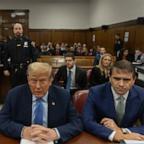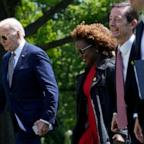Bill Barnwell's offseason report cards: NFC North
— -- After months of endless rumors, mock drafts and the occasional actual transaction, the player-movement portion of the NFL offseason is basically over.
Sure, a few guys might get traded between now and August, but most moves are in the can. What your favorite team's roster looks like now is just about what it's going to look like for the 2016 campaign.
So, now that everything is settled, let's run through the NFL and take a bird's-eye view of each team's offseason. The NFC North as a whole performed very well and made a lot of smart moves this offseason. That's no surprise with the Packers and Vikings, who are two of the better-run organizations in football, but the Bears continue to show surprising signs of promise under former Saints executive Ryan Pace. Even the Lions, who were blindsided by the retirement of Calvin Johnson at the beginning of the offseason and unable to convince their star receiver to change his mind, mostly made logical decisions to try and emerge from life after Megatron.
To go directly to your favorite team, click the links below:
Chicago Bears
What Went Right
They solved their inside linebacker problem. No team upgraded more at any one position than the Bears did at inside linebacker this offseason. After undrafted free agent Christian Jones and failed pass-rusher Shea McClellin flailed in starting roles last season, John Fox found the focal points for his defensive rebuild. Jerrell Freeman and Danny Trevathan are three-down linebackers who will greatly aid a Bears defense that was 31st in DVOA against the run and 30th in the league in DVOA against passes to tight ends.
They signed Bobby Massie. Massie has developed into a competent right tackle, but part of the value in signing him comes with pushing Kyle Long back inside. Long looked far better at right guard during his first two years in the league than he did as a tackle last year, and the Massie signing could serve as an upgrade at two positions alongside the right side of Chicago's offensive line.
They had a smart draft. What has been fascinating about Bears general manager Ryan Pace is that he has acted very differently as a decision-maker than the executives in his previous stop, New Orleans. While the Saints have repeatedly gone after high-risk options in free agency and traded up for draft picks, Pace has been relatively conservative in free agency despite oodles of cap room and continues to make intelligent decisions during the draft.
It remains to be seen whether first-round pick Leonard Floyd will turn into a viable edge rusher, but throwing resources at the front seven certainly makes sense. Chicago also added a third-round interior disruptor in Jonathan Bullard. What we can say more confidently is that the Bears were effective in the trade market. While they did have to give up a fourth-rounder to move up two spots in the first round and snag Floyd ahead of the Giants, the Bears amassed a nifty haul in dealing down nine spots in the second round with Buffalo, picking up two fourth-rounders. They picked up another fourth-rounder for moving down seven additional spots with Seattle. Those picks come in handy.
What Went Wrong
They didn't do enough to improve the secondary. The Bears used two of those fourth-round picks to add defensive backs (S Deon Bush and CB Deiondre' Hall), which will hopefully help some. Otherwise, though, this is basically the same secondary which might very well have been football's worst last year. You can understand why the Bears brought back Tracy Porter, who flashed signs of his former self in 2015, and the inside linebackers will help, but the Bears badly needed somebody to compete with Porter and Kyle Fuller and could have invested in more at safety than Broncos backup Omar Bolden.
Left tackle is still a question mark at best. Charles Leno took over the left tackle job from free-agent disappointment Jermon Bushrod, which isn't saying a ton, but it would have been hard to argue that Leno did enough last year to justify keeping the job on a permanent basis. And while Pace did bring in Massie and help on the interior with Ted Larsen and Manny Ramirez, there's really nobody competing with Leno for that spot on the left side of the line. That's scary.
What's Next?
Come to terms on a long-term deal with Alshon Jeffery . The Bears have plenty of cap room even after franchising their star wide receiver, so there wasn't the same sort of hindrance with using the franchise tag for them as there would have been for teams in worse cap shape, but going year-to-year with Jeffery might become a problem. Jeffery's franchise tag for this year is worth $14.6 million, which leaves him with the fourth-largest cap hit for any wideout in football. If the Bears franchise him again in 2017, that figure would rise to $17.5 million, which would be tops among all WRs.
Grade: B
Detroit Lions
What Went Right
They emphasized the offensive line in rebuilding their offense. Long in need of help up front, the Lions have used first-round picks on players such as Riley Reiff and Laken Tomlinson with limited returns. Tomlinson flashed some promise last year as a rookie, and Reiff has been serviceable at tackle, but outside of Larry Warford, the Lions needed more building blocks up front.
So you can't fault new Lions general manager Bob Quinn for using a first-round pick on massive Ohio State tackle Taylor Decker. He will likely start on the right side as a rookie and may eventually move over to protect Matthew Stafford's blind side if the Lions don't re-up Reiff after this season. While Quinn was missing a third-round pick after a short-sighted trade during last year's draft saw the Lions move up to grab defensive tackle Gabe Wright (who was a healthy scratch by the second half), Quinn used his compensatory third-rounder to nab Michigan interior lineman Graham Glasgow. He also signed former Giants lineman Geoff Schwartz to a one-year deal for $860,000, a worthwhile risk for a guard who has been effective when healthy.
They brought Haloti Ngata back. While Ngata wasn't the weapon he once was with the Ravens during his debut season in Detroit, he played more effectively as the season went along, which was true of much of the Lions' defense. In a market where defensive linemen were getting mammoth deals, signing Ngata for two years and $12 million with just $6 million guaranteed was a victory.
What Went Wrong
Calvin Johnson retired. Not part of the grade, but, well, that's no fun.
They paid Marvin Jones a premium to replace Calvin Johnson. It's not fair to expect Jones to live up to the Hall of Fame stature of Megatron, and the Lions were stuck shopping for wide receivers in a market where there wasn't much available, but Detroit paid a staggering premium for a receiver who has a broken foot in his recent injury history and posted a pedestrian 65-816-4 line during his best season in Cincinnati. Jones got $13 million guaranteed and $27 million over the first three years of his deal. That's roughly comparable to what T.Y. Hilton ($28 million) got over the first three years of his contract, and keep in mind that Hilton's deal (for a far more productive player than Jones) was regarded around the league as an overpay. The Lions were desperate, but you have to wonder if they would have been better off just going with a couple of veteran free agents on the cheap and drafting somebody like Tyler Boyd to chip in.
They lost Isa Abdul-Quddus . Before their Week 9 bye, the Lions allowed opposing quarterbacks to post a QBR of 83.0, the worst figure in football. (Worse than the Saints!) They inserted Abdul-Quddus into the starting lineup at safety for James Ihedigbo during the bye week, and afterward, their pass defense was remarkably better. The Lions improved to 23rd down the stretch with a QBR allowed of 67.0; not great, and Abdul-Quddus wasn't the only force driving that improvement, but he sure helped. It would have been nice to hold onto a 26-year-old safety who helps out on special teams and apparently has some upside as a starter in the backfield, but the Dolphins snatched him up on a three-year, $12.8 million deal.
What's Next?
Re-signing their young core. Megatron's $12.9 million in dead money comes off of Detroit's cap next year, so while that might give Lions fans hope of a big spending splurge in free agency, they'll need to use that money to lock up the useful players drafted by Martin Mayhew. That starts with Warford, who is one of the league's better guards and in line for a huge raise from the $1.8 million he'll earn in 2016. Quinn will need to make a tough call on Reiff, who might not be an average left tackle even if teams are willing to pay him like one in free agency. The real burden will be re-signing superstar edge rusher Ezekiel Ansah, but the Lions can't do that until next offseason, anyway.
Grade: C+
Green Bay Packers
What Went Right
They continued to listen to Ted Thompson. Despite reports that head coach Mike McCarthy was upset at Thompson for mostly avoiding free agency in years past, Thompson's planning has left the Packers with one of the deepest rosters in all of football on an annual basis. The Packers never lose players they want to keep and perennially replenish their roster with useful draft picks, including the two compensatory fourth-round picks they added this year.
Thompson did give away fourth- and seventh-round picks to move up in the second round and grab swing tackle Jason Spriggs, which isn't exactly ideal, but hopefully you'll understand if I have more faith in Thompson's machinations on draft day than I do when Doug Whaley and Mike Tannenbaum trade up. Thompson's trades in years past have been a mixed bag; he dealt three picks to move into the first round and grab Clay Matthews (in a deal which eventually netted the Patriots Julian Edelman and Rob Gronkowski), but they also moved up in the second round of the 2012 draft to grab Jerel Worthy. You can guess which trade Packers fans are hoping the Spriggs deal emulates.
What Went Wrong
They didn't do enough to move Clay Matthews to outside linebacker on a full-time basis. McCarthy is right, though, to want Matthews back as an edge rusher and outside linebacker. Given how cheap useful inside linebackers can be, you can make a case that Thompson didn't do enough to make it easy for the Packers to push Matthews outside. Fourth-rounder Jake Ryan ended up contributing after starter Sam Barrington went on injured reserve in September, and both Ryan and Barrington will compete for snaps with rookie fourth-rounder Blake Martinez, but why couldn't the Packers have been in for somebody like Karlos Dansby? Dansby wouldn't have cost the Packers in the compensatory draft pick equation, and they could have easily afforded his one-year, $2 million deal.
There's a Brett Hundley-sized hole behind Aaron Rodgers . Green Bay's franchise quarterback was downright incredible in the playoff loss to Arizona and hasn't missed a game in two years, but we only have to go back to 2013 to remember how acutely the Packers feel his absence. There's no way the Packers can find a backup who approximates Rodgers, but there has to be a more meaningful middle ground behind paying a premium for somebody like Sam Bradford or Chase Daniel and turning over the backup's job to Hundley, a 2015 fifth-rounder. Matt Flynn is still unsigned, so the Packers could theoretically call him up again if Rodgers missed a huge chunk of time, but you get the idea. There's not much to complain about with the Packers when it comes to their offseasons.
What's Next?
Re-sign their offensive line. Starting guards Josh Sitton and T.J. Lang and left tackle David Bakhtiari are all unrestricted free agents after this season, which can't bode well for Packers fans who value Rodgers' personal safety. Spriggs may profile as the long-term solution at left tackle if Thompson thinks that it's not worth paying a premium for Bakhtiari. But there's no such option lurking behind Sitton and Lang at guard, where the cupboard is stocked with undrafted free agents. Thompson surely has to re-sign either Sitton or Lang to a long-term deal.
Grade: B
Minnesota Vikings
What Went Right
They built up their offensive line depth. Last year, the Minnesota line was doomed before the season even began. The Vikings lost right tackle Phil Loadholt to a torn Achilles in training camp, while center John Sullivan missed all of 2015 with a back injury. Backup Joe Berger filled in ably for Sullivan and problematic left tackle Matt Kalil cut his sack totals down from 13.75 in 2014 to a more respectable 5.5 sacks allowed, but the offensive line limited what Norv Turner could do with Teddy Bridgewater and the passing game.
While Vikings general manager Rick Spielman didn't come away with any stars in free agency, he has built one of the league's deepest lines. Sullivan and Loadholt are both back, with Loadholt taking a pay cut to return. In addition, the Vikings signed Alex Boone away from the 49ers to start at guard before adding Andre Smith at tackle from the Bengals. Both Boone and Smith were playing at a high level in 2013 before slipping the past two years, but neither is being paid big bucks. Smith is on a one-year deal, and Boone has no guaranteed money after this season. With Berger also returning to the fold as a utility lineman, Minnesota goes eight-deep with useful players up front. Nobody else in the league can say that.
Samesies for the secondary. In his last stop, Mike Zimmer's Bengals defenses were built around a deep rotation of cornerbacks and athletic playmakers up front. That has translated over to his new digs in Minnesota. The Vikings have focused on adding contributors at cornerback over the past couple of years, and it's paying off. In addition to re-signing ageless wonder Terence Newman, who was a competent starter at 36 last season, the Vikings brought in former Panthers starter Melvin White and used a second-round pick on Mackensie Alexander, who lacks prototypical size, but has NFL-caliber coverage skills and athleticism.
The Vikes can and will bring Alexander along slowly, given the depth they have at the position and Zimmer's habit (both in Cincinnati and Minnesota) of letting his cornerbacks work their way into starting roles. 2015 first-rounder Trae Waynes started only one game last year, but it was notable that his lone interception came against Russell Wilson in the playoffs. It wouldn't be a surprise to see Waynes starting next to the underrated Xavier Rhodes by the end of 2016.
They took advantage of the Dolphins during the draft. Spielman made one notable bad trade up early in his tenure, sending four picks to the Patriots to move up and grab Cordarrelle Patterson in a deal that eventually netted the Pats Jamie Collins. Since then, he has been smart to trade down and acquire additional picks. The Dolphins were polite enough to hand him three picks last month, with Spielman sending the 86th selection -- the 23rd pick of the third round -- to Miami for a sixth-round pick as well as 2017 third- and fourth-round picks. If Miami is a league-average team and the fourth-rounder manages to be a compensatory pick (which is in the terms of the deal), the Vikings would be getting $1.89 on the dollar to make that trade. That's thievery.
What Went Wrong
They haven't come to terms with Harrison Smith on an extension yet. It's hard to find much fault with what the Vikings have done this offseason, so this is really the closest thing to a mistake Spielman has made. Smith is about as good as it gets at safety in the NFC after Earl Thomas, and while the Vikings have him locked up through 2016 on his fifth-year option at $5.3 million, they'll want to keep him around for the next few years. That's about it. The Vikings are smart.
What's Next
Lock Smith up long term. This should be rectified shortly.




